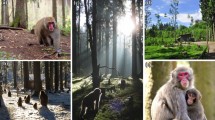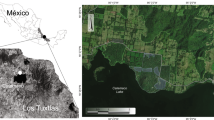Abstract
A cross-sectional demographic analysis of the entire baboon population of the Amboseli basin of southern Kenya was undertaken to complement the lon-gitudinal, intensive studies of a subpopulation. The present survey documented the extent and persistence of the influx of anubis baboons into the predominantly cynocephalus community and provided another example of the nonrandom dispersal patterns of cercopithecine males. In addition, the survey confirmed continued demographic stability of the basinwide baboon population and even growth in groups that had access to better feeding conditions, despite decline of the baboons' preferred habitat and expansion of human activities into wildlife areas. Conflicts with activities of humans, however, indicate that the present well-being of the Amboseli baboon population may be short-lived.
Similar content being viewed by others
References
Altmann, J. (1980).Baboon Mothers and Infants. Harvard University Press, Cambridge.
Altmann, J. (1986). Adolescent pregnancies in non-human primates: An ecological and developmental perspective. In Lancaster, J., and Hamburg, B. (eds.),School-Age Pregnancy and Parenthood. Aldine, Chicago, pp. 247–262.
Altmann, J., and Muruthi P. (1988). Differences in daily life between semiprovisioned and wild-feeding baboons.Am. J. Primatol. 15:213–221.
Altmann, J., Hausfater, G., and Altmann, S. A. (1981). Physical maturation and age estimates in yellow baboons,Papio cynocephalus, in Amboseli National Park, Kenya.Am. J. Primatol, 1:389–399.
Altmann, J., Hausfater, G., and Altmann, S. A. (1985). Demography of Amboseli baboons, 1963–1983.Am. J. Primatol. 8:113–125.
Altmann, J., Altmann, S. A., and Hausfater, G. (1988). Determinants of reproductive success in yellow baboons. In Clutton-Brock, T. H. (ed.)Reproductive Success, University of Chicago Press, Chicago, pp. 403–418.
Altmann, S. A. (1977).The Acacia Woodland of Amboseli National Park: Current Status and Future Prospects, Report submitted to the Director, Kenya National Parks.
Altmann, S. A., and Altmann, J. (1970).Baboon Ecology, University of Chicago Press, Chicago.
Asquith, P. J. (1989). Provisioning and the study of free-ranging primates: History, effects and prospects.Yearb. Phys. Anthropol. 32:129–158.
Buettner-Janusch, J. (1966). A problem in evolutionary systematics: Nomenclature and classification of baboons, GenusPapio. Folia Primatol. 4:288–308.
Cheney, D. L., and Seyfarth, R. M. (1983). Nonrandom dispersal in free-ranging vervet monkeys: Social and genetic consequences.Am. Nat. 122(3):392–412.
Cheney, D. L., Seyfarth, R. M., Andelman, S. J., and Lee, P. C. (1988). Reproductive success in vervet monkeys. In: Clutton-Brock, T. H. (ed.),Reproductive Success, University of Chicago Press, Chicago, pp. 384–402.
Dittus, W. P. J. (1977). The social regulation of population density and age-sex distribution in the toque macaque.Behaviour 63:281–322.
Else, J., and Eley, D. (1985). Don't feed the monkeys.Swara 8:31–32.
Fa, J. E., and Southwick, C. H. (1988).Ecology and Behavior of Food-enhanced Primate Groups, Monographs in Primatology, Vol. 11, Alan R. Liss, New York.
Goodall, J. (1986).The Chimpanzees of Gombe, Harvard University Press, Cambridge.
Hamilton, W. J., III (1985). Demographic consequences of a food and water shortage to desert chacma baboons,Papio ursinus.Int. J. Primatol. 6(5):451–462.
Harcourt, A. H., Fossey, D., Stewart, K., and Watts, D. P. (1980). Reproduction in wild gorillas and some comparisons with chimpanzees.J. Reprod. Fertil. Suppl. 28:59–70.
Harcourt, A. H., Fossey, D., and Sabatier Pi, J. (1981). Demography ofGorilla gorilla.J. Zool. Lond. 195:215–233.
Hausfater, G., Altmann, J., and Altmann, S. A. (1982). Long-term consistency of dominance relations among female baboons (Papio cynocephalus).Science 217:752–755.
Jolly, C. J., and Brett, F. L. (1973). Genetic markers and baboon biology.J. Med. Primatol. 2:85–99.
Kingdon, J. (1974).East African Mammals, Vol. 1, University of Chicago Press, Chicago.
Lee, P. C., Brennan, E. J., Else, J. G., and Altmann, J. (1986). Ecology and behavior of vervet monkeys in a tourist lodge habitat. In Else, J. G., and Lee, P. C. (eds.),Primate Ecology and Conservation, Cambridge University Press, Cambridge, pp. 229–235.
Lovatt Smith, D. (1986).Amboseli, Nothing Short of a Miracle, East African Publishing House, Nairobi.
Lyles, A. M., and Dobson, A. P. (1988). Dynamics of provisioned and unprovisioned primate populations. In Fa, J. E., and Southwick, C. H. (eds.),Ecology and Behavior of Food-enhanced Primate Groups, Monographs in Primatology, Vol. 11, Alan R. Liss, New York, pp. 167–198.
Maples, W. R., and McKern, T. W. (1967). A preliminary report on classification of the Kenya baboon. In Vartborg, H. (ed.),The Baboon in Medical Research, Vol. 2, University of Texas Press, Austin, pp. 13–22.
Napier, J. R., and Napier, P. H. (1967).A Handbook of Living Primates, Academic Press, New York, London.
Norton, G. W., Rhine, R. J., Wynn, G. W., and Wynn, R. D. (1987). Baboon diet: A five-year study of stability and variability in the plant feeding and habitat of the yellow baboons (Papio cynocephalus) of Mikumi National Park, Tanzania.Folia Primatol. 48:78–120.
Packer, C. (1979). Inter-troop transfer and inbreeding avoidance inPapio anubis Anim. Behav. 27:1–36.
Rolland, R., Hausfater, G., and Levy, S. B. (1985). Antibiotic resistance in wild baboons: Increased prevalence in baboons feeding on human refuse.Appl. Environ. Microbiol. 49(4):791–794.
Samuels, A., and Altmann, J. (1986). Immigration of aPapio anubis male into a group ofPapio cynocephalus baboons and evidence for ananubis-cynocephalus hybrid zone in Amboseli, Kenya.Int. J. Primatol. 7(2):131–138.
Sapolsky, R. M., and Else, J. G. (1987). Bovine tuberculosis in a wild baboon population: Epidemiological aspects.J. Med. Primatol. 16:229–235.
Southwick, C. H., and Siddiqi, M. F. (1976) Demographic characteristics of semi-protected rhesus groups in India.Yearb. Phys. Anthropol. 20:242–252.
Southwick, C. H., and Siddiqi, M. F. (1977). Population dynamics of rhesus monkeys in northern India. In Prince Rainier III and Bourne, G. H. (eds.)Primate Conservation, Academic Press, New York, pp. 339–362.
Southwick, C. H., Siddiqi, M. F., and Oppenheimer, J. R. (1983). Twenty-year changes in rhesus monkey populations in agricultural areas of northern India.Ecology 64(3):434–439.
Struhsaker, T. T. (1973). A recensus of vervet monkeys in the Masai-Amboseli Game Reserve, Kenya.Ecology 54:930–932.
Struhsaker, T. T. (1976). A further decline in numbers of Amboseli vervet monkeys.Biotropica 8:211–214.
Strum, S. C. (1987).Almost Human, Random House, New York.
Van Citters, R. L., Smith, O. A., Franklin, D. L., Kemper, W. S., and Watson, N. W. (1967). Radio telemetry of blood flow and blood pressure in feral baboons: A preliminary report. In Vartborg, H. (ed.),The Baboon in Medical Research, Vol. 2, University of Texas Press, Austin, pp. 473–492.
Walters, J. (1980). Interventions and the development of dominance relationships of female baboons.Folia Primatol. 34:61–89.
Western, D. (1973).The Structure, Dynamics, and Changes of the Amboseli Ecosystem, Ph.D. thesis, University of Nairobi.
Western, D. (1983).A Wildlife Guide and a Natural History of Amboseli, Author, Nairobi.
Western, D., and Sindiyo, D. M. (1972). The status of the Amboseli rhino population.E. Afr. Wildl. J. 10:43–57.
Western, D., and van Praet, C. (1973). Cyclical changes in the habitat and climate of an east African ecosystem.Nature 241:104–106.
Wrangham, R. W. (1974). Artificial feeding of chimpanzees and baboons in their natural habitat.Anim. Behav. 22:83–93.
Author information
Authors and Affiliations
Rights and permissions
About this article
Cite this article
Samuels, A., Altmann, J. Baboons of the amboseli basin: Demographic stability and change. International Journal of Primatology 12, 1–19 (1991). https://doi.org/10.1007/BF02547555
Received:
Revised:
Issue Date:
DOI: https://doi.org/10.1007/BF02547555




